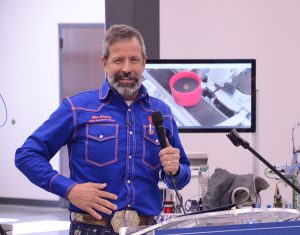Gov. Sanders creates workforce cabinet; names Tyson exec to lead
by February 9, 2023 1:46 pm 4,794 views

Gov. Sarah Sanders created the Governor’s Workforce Cabinet and appointed Tyson Foods’ Mike Rogers as chief workforce officer via executive order Thursday (Feb. 9).
The cabinet will advise the governor on workforce development and career education issues. The chief workforce officer will chair the cabinet and will direct the governor’s workforce development policies and career education strategy.
The cabinet will be composed of the secretaries or their designees of the Departments of Commerce, Corrections, Education, Human Services, Labor and Licensing, and Veterans Affairs.
It is tasked with preparing a data-driven strategic plan by Oct. 1 and at her direction create working groups composed of community and business leaders, educators, workforce development experts and the state’s chief data officer, who is currently Dr. Josh McGee.
“Before today, plenty of different areas of state government played a role in workforce, but never met to coordinate frequently. We’re going to change that,” she said. “This order brings them together in the same room as the springboard for future programs that train workers, cut red tape, and lower taxes.”
Former Gov. Mike Beebe had an active workforce cabinet of agency and industry leaders led by former Department of Workforce Services director Artee Williams.

Mike Rogers is Tyson Foods’ senior director of maintenance and refrigeration. According to the governor’s office, his team conducts trainings across the country on industrial maintenance, refrigeration and reliability engineering. He taught agricultural and industrial maintenance at Siloam Springs High School for 20 years and was the school district’s energy manager for 16 years.
Sanders said she met Rogers during her campaign during a workforce development roundtable discussion. They met in the same room where she signed today’s executive order at the Saline County Career Technical Campus. She knew she wanted to hire him when she left that first meeting.
“I’ll let the governor know that I wouldn’t have gone to work for anybody,” Rogers said in his remarks. “I needed radical support, radical views, and to take some of the good things that have already happened in this state and make them better. I don’t follow other states’ other ideas. I want to make something custom and unique specifically for Arkansas.”
Sanders said the order reflects her Arkansas LEARNS education proposal, which she described in some detail in a public event Wednesday (Feb. 8). The proposal, which would be created through legislation, creates a program where local employers would work with high schools to create a dual-track catalog letting students graduate into jobs.
“In Arkansas, fewer than half of Arkansas graduates receive post-grad workforce education, but six in 10 jobs require credentials beyond a high school diploma,” she said. “Unless we act now, that gap will only get bigger in the future. For our young people to have the skills they need to help our economy grow, we have to invest in them before, during and after they earn their high school diploma.”
In addition to workforce development, the LEARNS program involves increasing minimum teacher salaries to $50,000 from the current $36,000, and creating “education freedom accounts” where parents could use state funds to help pay for private school and homeschooling.
Sanders signed the executive order at the Saline County Career Technical Campus, a workforce training facility for students and adults operated as part of the Arkansas State University System and ASU – Three Rivers. The 134,159-square-foot center opened in the fall of 2021 and was constructed after voters passed a 3/8ths-cent sales tax.
The order was signed in the center’s advanced manufacturing space, which trains students and adults on equipment used by local industries. Around the room were electrical, pneumatic and motor control equipment. Future additions will include 3D printers and computer numerical control equipment, said Assistant Vice Chancellor Scott Kuttenkuler.
“In the building itself, we’ll have over 200 kids that will graduate and walk across our college stage before they walk across their high school stage this year,” he said.
